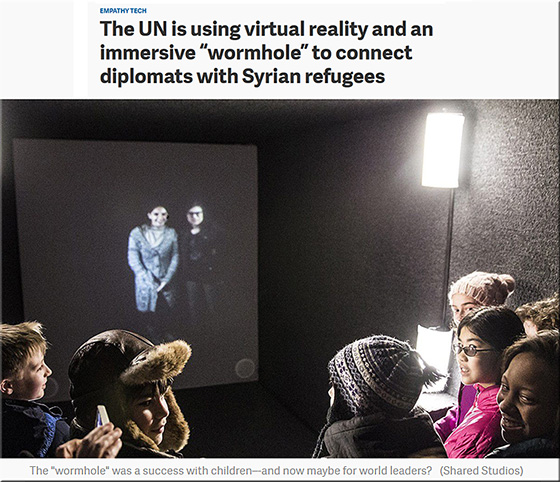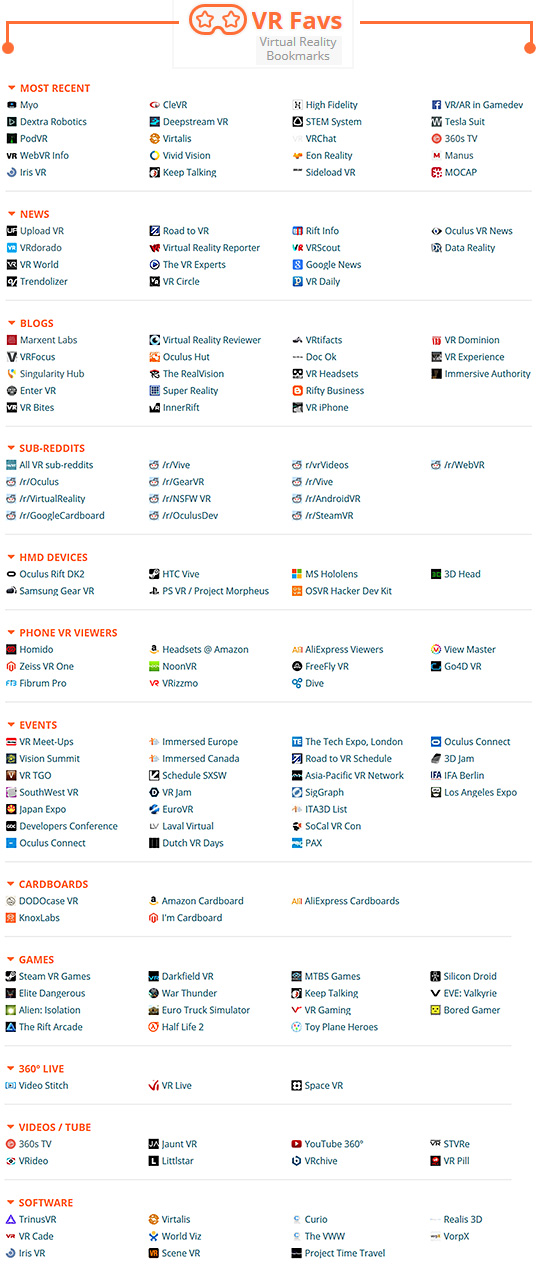Empathy Tech: The UN is using virtual reality and an immersive “wormhole” to connect diplomats with Syrian refugees — from qz.com by Hanna Kozlowska
Excerpt (emphasis DSC):
On their way to this month’s 70th United Nation’s General Assembly, the organization’s annual high-level meeting in New York, diplomats and world leaders will pass by a makeshift glass structure—both a glossy multi-media hub, and a gateway to an entirely different world.
The hub uses virtual reality to allow the UN attendees to see Jordan’s Zaatari camp for Syrian refugees through the eyes of a little girl. And, by using an immersive video portal, which will launch later this week, they will have the opportunity to have face-to-face conversations with residents of the camp.
The effort aims to put a human face on the high-level deliberations about the refugee crisis, which will likely dominate many conversations at the United Nations General Assembly (UNGA). UN Secretary General Ban Ki-Moon has called on the meeting to be “one of compassion, prevention and, above all, action.”
From DSC:
VR-based apps have a great deal of potential to develop
and practice greater empathy. See these related postings:
Using virtual reality to overcome fear, reduce prejudice
How might virtual reality change the world? Stanford lab peers into future
UMBC professors think virtual reality can change research — from technical.ly/baltimore by Stephen Babcock
And the university is building an immersive VR environment to find out.
Excerpt:
When it comes to virtual reality, the University of Maryland, Baltimore County is going for full immersion.
Armed with funding from the National Science Foundation, the university is set to build a virtual reality “environment” that’s designed to help researchers from different fields. It’s called PI2.
In the 15-by-20-foot room, stepping into virtual reality won’t necessarily require goggles.

A visualization wall at the University of Illinois at Chicago’s Electronic Visualization Lab.
UMBC officials say their project will be similar to this.(Photo courtesy of Planar)
The Ultimate Alternate Reality Gamified Transmedia Classroom Toolkit — from ludiclearning.org
Excerpt:
Now you’re ready to turn your class into an immersive game, and everything you need is right here. With the help of these resources, you can develop your own gameful class, cook up a transmedia project, design a pervasive game or create your very own [Augmented Reality Game] ARG. Games aside, these links are useful for all types of creative learning projects. In most cases, what is on offer is free and/or web based, so only your imagination will be taxed.
Also see:

From DSC:
In the future, teams of specialists will create some great
learning-related experiences, integrating AR and VR into them.
Microsoft lab working on multiperson augmented reality — from cnet.com by Michelle Starr
Project Comradre will allow multiple people, each wearing an AR headset, to interact with the same virtual object.
Excerpt:
If augmented reality could be a shared experience, it could change the way we will use the technology.
Something along these lines is currently in development at a Microsoft laboratory run by Jaron Lanier, one of the pioneers of VR since the 1980s through his company VPL Research. The project, called Comradre, allows multiple users to share virtual- and augmented-reality experiences, reports MIT Technology Review.
Because virtual reality takes place in a fully digital environment, it is not hugely difficult to put multiple users into the same virtual instance at the same time, wirelessly synced across multiple headsets.
vrfavs.com — some serious VR-related resources for you. Note: There are some NSFW items on there; so this is not for kids.
VR and Augmented Reality will soon be worth $150 billion. Here are the major players — from fastcompany.com by Daniel Terdiman; with thanks to Woontack Woo for this resource
A new report suggests AR will be eventually worth four times as much as VR.
Excerpt:
Together, virtual reality and augmented reality are expected to generate about $150 billion in revenue by the year 2020.
Of that staggering sum, according to data released today by Manatt Digital Media, $120 billion is likely to come from sales of augmented reality—with the lion’s share comprised of hardware, commerce, data, voice services, and film and TV projects—and $30 billion from virtual reality, mainly from games and hardware.
The report suggests that the major VR and AR areas that will be generating revenue fall into one of three categories: Content (gaming, film and TV, health care, education, and social); hardware and distribution (headsets, input devices like handheld controllers, graphics cards, video capture technologies, and online marketplaces); and software platforms and delivery services (content creation tools, capture, production, and delivery software, video game engines, analytics, file hosting and compression tools, and B2B and enterprise uses).

5 Ways to Use Augmented Reality App Aurasma in Your Class — from educatorstechnology.com
Excerpt:
Talking about augmented reality technology in teaching and learning the first thing that comes to mind is this wonderful app called Aurasma. Since its release a few years ago, Aurasma gained so much in popularity and several teachers have already embraced it within their classrooms. For those of you who are not yet familiar with how Aurasma works and how to use in it in your class, this handy guide from Apple in Education is a great resource to start with.
New Toybox Trailer Shows Oculus Touch’s Capabilities — from vrfocus.com; with thanks again to Woontack Woo for this resource
Excerpt:
The Oculus Touch virtual reality (VR) controllers finally have their first full videogames. A handful of titles were confirmed to support the kit back at the Oculus Connect 2 developer conference in September. But still one of the most impressive showcases of what these position-tracked devices can do exists in Oculus VR’s original tech demo, Toybox. [On 10/13/15], Oculus VR itself has released a new video that shows off what players are able to do within the software.
Glen Keane – Step into the Page
Escape Virtual Reality with Telekinetic Powers — from blog.leapmotion.com by Cade Peterson
Excerpt:
Much like sketching the first few lines on a blank canvas, the earliest prototypes of a VR project is an exciting time for fun and experimentation. Concepts evolve, interactions are created and discarded, and the demo begins to take shape.Competing with other 3D Jammers around the globe, Swedish game studio Pancake Storm has shared their #3DJam progress on Twitter, with some interesting twists and turns along the way. Pancake Storm started as a secondary school project for Samuel Andresen and Gabriel Löfqvist, who want to break into the world of VR development with their project, tentatively dubbed Wheel Smith and the Willchair.
Also see:
No Google CardBoard? Try NearPod Virtual Field Trips — from bergman-udl.blogspot.ca
Excerpt:
Recently I learned about a new feature called Virtual Field Trips. In a partnership with 360 Cities, NearPod now gives teachers and students the opportunity to view pristine locations like the Taj Mahal, the Golden Gate Bridge, and The Great Wall of China. You can view famous architecture, famous artifacts, and even different planets! Virtual Field Trips are a great addition to any classroom.
How this med school is using virtual reality to teach students — from fortune.com by John Gaudiosi
Excerpt:
Western University of Health Sciences in Pomona, Calif., has opened a first-of-its-kind virtual reality learning center that’s been designed to allow students from every program—dentistry, osteopathic medicine, veterinary medicine, physical therapy, and nursing—to learn through VR.
The Virtual Reality Learning Center currently houses four different VR technologies: the two zSpace displays, the Anatomage Virtual Dissection Table, the Oculus Rift, and Stanford anatomical models on iPad.
Robert W. Hasel, D.D.S., associate dean of simulation, immersion & digital learning at Western, says VR gives anatomical science teachers the ability to view and interact with anatomy in a way never before experienced. The virtual dissection table allows students to rotate the human body in 360 degrees, take it apart, identify specific structures, study individual systems, look at multiple views at the same time, take a trip inside the body, and look at holograms.

——————————————
——————————————
Addendum on 10/20/15:
- Can Virtual Reality Replace the Cadaver Lab? — from centerdigitaled.com by Justine Brown
Colleges are starting to use virtual reality platforms to augment or replace cadaver labs, saving universities hundreds of thousands of dollars.
——————————————
——————————————













